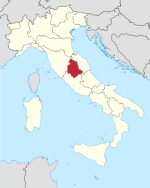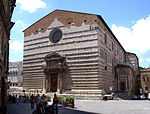Tiberina Republic
1798 in EuropeClient states of the Napoleonic WarsFrench military occupationsHistory of UmbriaItalian history stubs ... and 4 more
Italian statesPerugiaStates and territories disestablished in 1798States and territories established in 1798

The so-called Tiberina Republic (Italian: Repubblica Tiberina) was a revolutionary municipality proclaimed on 4 February 1798, when republicans took power in the city of Perugia. It was an occupation zone that took its name from the river Tiber. A month later, the government of all the Papal States was changed into a republic: the Roman Republic, which Perugia belonged to. Its head was a consul and it used a tricolor similar to the French flag.
Excerpt from the Wikipedia article Tiberina Republic (License: CC BY-SA 3.0, Authors, Images).Tiberina Republic
Piazza IV Novembre, Perugia Sant'Erminio
Geographical coordinates (GPS) Address Nearby Places Show on map
Geographical coordinates (GPS)
| Latitude | Longitude |
|---|---|
| N 43.112222222222 ° | E 12.388888888889 ° |
Address
Piazza IV Novembre
Piazza IV Novembre
06122 Perugia, Sant'Erminio
Umbria, Italy
Open on Google Maps








